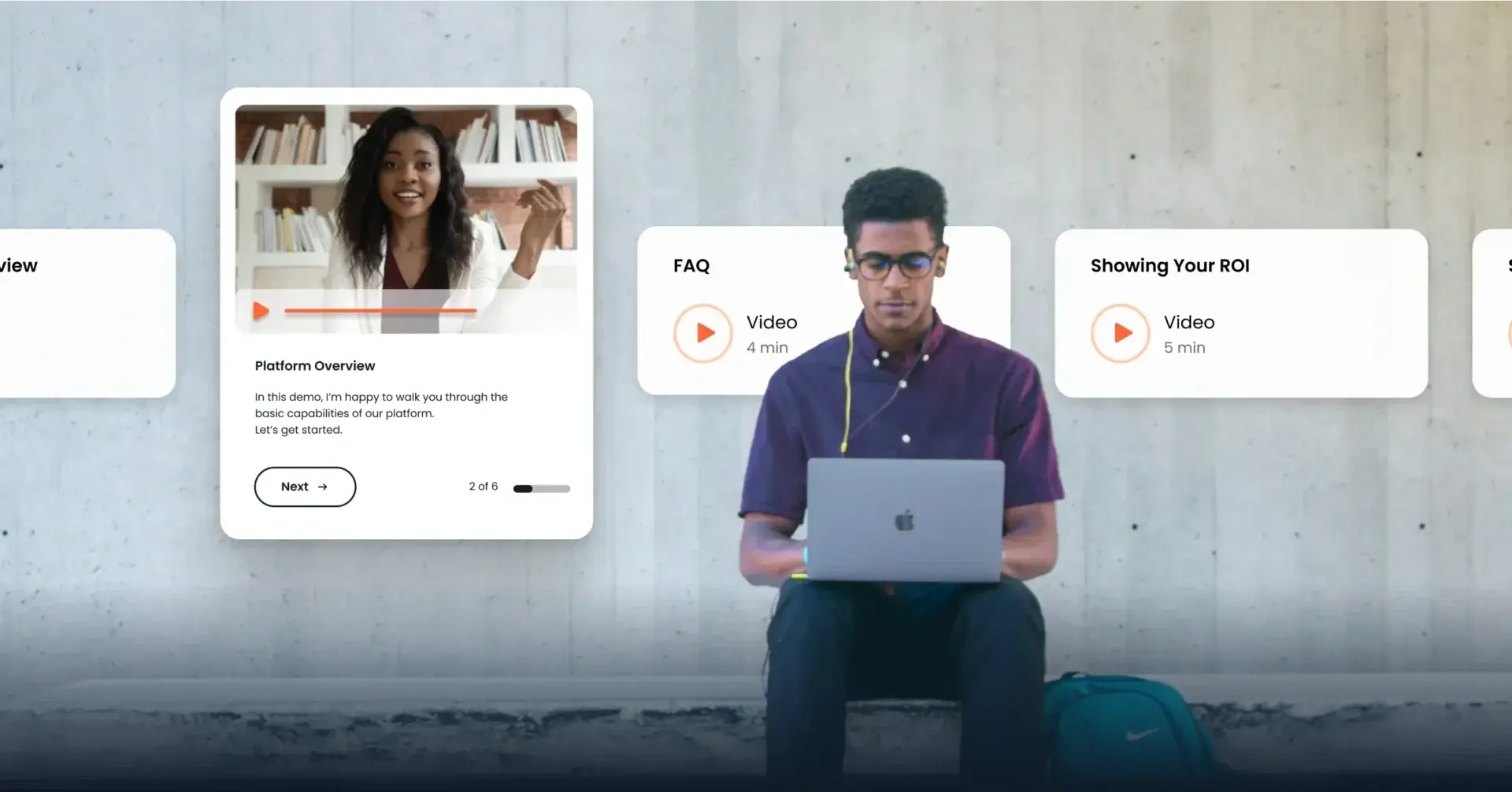I started out in enterprise sales and had a great run for a little over 10 years. But I was always ...
Close more deals with
Demo Automation.
Watch a Demo
How long do your qualified buyers have to wait for a demo?
The median for all buyers is 5.6 days, or more than a week. 38% of survey respondents said their prospects wait 6 days or more. Longer wait times are closely correlated with larger buying groups and larger companies, which makes sense. The more people involved; the harder it is to get something done.
We won’t debate whether delays are good or bad. That’s settled science. When people want to see something, they don’t want to be forced to wait. “Forced” is the key word here – as if the AEs’ or SEs’ calendars were sacred. They’re not! The buyer’s calendar sure is though. And they want to see things on their terms and at their pace.
So these delays are nothing more than lost time, multiplied across potentially hundreds, if not thousands, of customers. They’re delays in uncovering stakeholders and stakeholder priorities. They’re friction in the buying process; an unacceptable bottleneck. They’re a window of opportunity for competitors and a million other distractions. They’re a cooling off of the initial heat and excitement that prompted them to want a demo in the first place.
The question isn’t, “How do we do more demos more quickly?” Trying to tackle that is just an exercise in doing more of the wrong things, more often.
You should be asking yourselves, “How do we do fewer wasted demos and more qualified, high-impact demos?”
Unpacking “wasted demos”
If prospects have to wait a week or two for a demo, surely that must be a function of impeccable qualification yielding tons of qualified customers, and tons of demand for demos, clogging up the process, right?
It’s true there’s a lot of demand for SEs to deliver demos, and it’s not all coming from sales. Just 2% of Presales teams support sales exclusively. But the bulk of the demand for Presales still comes from Sales, whose teams are growing pretty fast.
Not just growing, but ramping much more quickly – AEs onboard in 3-4 months on average, SEs take 6-12. Which is why SEs deliver 40% more demos per week than last year, and burn out faster.
They’re busier, but is that time more effective?
30-50% of demos delivered are unqualified! The 3rd biggest time suck for Presales teams remains repetitive intro demos with unqualified customers.
“How do we do fewer wasted demos and more qualified, high-impact demos?”
You can’t eliminate intro demos – repetitive or not – and it can be hard to quickly determine which customers are unqualified until you demo.
But we know what a qualified customer looks like and what goes into a highly customized, technical demo or POC for qualified customers.
So it really comes down to bridging the gap between the repetitive intro demos and the live, highly customized, technical demos.
I can tell you that you can solve this with at least these two steps:
Step 1: Align your demos and how you deliver them to the 6 demo types.
Most people don’t even realize there are 6 types of demos, or that 5 of them can be automated and delivered on-demand. Remember, the objective isn’t to deliver fewer demos as a whole; it’s to deliver fewer wasted demos and more high-impact, high-value demos to qualified customers. Automate the demos that don’t require a live, customized walk through, and you immediately free up time for the truly important activities.
Step 2: Implement the Demo Qualified Lead (DQL) stage to your buying process.
Without a way to qualify demos, or qualify time with Presales more broadly, you’ll always have an unnecessary level of waste, which puts focused time with qualified customers at risk. Some organizations have been successful in reducing lag times by delegating certain demos to Sales, CS and other teams. But it generally only trims the wait time down to 4 business days, and doesn’t solve the underlying problem of unqualified demos. That’s where the DQL really shines.
What is a Demo Qualified Lead?
A Demo Qualified Lead (DQL) is an ICP customer who engages sufficiently with, and shares, interactive video demos.
In Marketing and Sales, we use scores like intent and engagement to qualify prospects for the attention of BDRs and AEs (i.e. MQL, SQL). There’s nothing for Presales, which is why so many unqualified (and underqualified) customers blow up their calendars with wasted demos and distract them from more important activities.
If your website has a button to REQUEST A DEMO, for example, anyone can click it, whether or not they’re qualified. Maybe there’s a gate to gather some signals for qualification, and maybe the BDR calls them up to see if they’re really a fit.
But now you’re just stretching things out needlessly for the buyer. They’ll probably ask the BDR for a demo (again), but the BDR will first hand them over to the AE. The AE does some discovery, at which point the buyer (again) asks for a demo. At this point, the AE makes the request to Presales, and the buyer waits 5.6 days. So even our measure of demo lag time doesn’t include the first part of the process that began with Marketing.
That’s anything but a frictionless experience for buyers, and it’s precisely what the DQL solves.
Using the DQL Effectively
There is no one strategy for building a DQL methodology, but it’s important to have some way to filter out serious demo requests. Take the company Trintech as an example of what DQLs can do. Their presales team found that over 50% of their demos were unqualified and their customers had a 14-day lag time between demo requests and delivery.
By using DQLs and demo automation, they were able to reduce the number of unqualified demos to 5% and the wait time disappeared completely as demos were able to be sent on demand. Trintech requires their prospects to watch their automated demos before they commit presales resources to them.
How much more time would eliminating unqualified demos give you to hit the same quota, and how many more deals would you close? Once you find a way to screen out unqualified demos, you can be confident the demo your presales team delivers is worth their time.
A lot of teams insert the DQL stage between the AE and SE, before that 5.6 day delay materializes. They require customers to engage with an automated demo before getting access to the Presales team. The buyer receives the intro demo as a link in their inbox, which they can view at their own time and pace, and which they can share with colleagues.
The buyer has shown engagement and interest, they’ve most likely shared the demo, the people they’ve shared it with have engaged, and once they jump on a live call with Presales it feels more like a 3rd or 4th call. The primary champion is well-informed, as are their stakeholders, and the Presales rep knows exactly what the buyer’s team has elected as their top priorities.
At Consensus, we start the process even earlier. The way we do it is we give website visitors a CTA to access an on-demand, interactive video demo directly. People who take the time to go through it are our highest converting leads by over 20%.
Closing
It seems every portion of the sales cycle has some form of qualification, except Presales.
Do you know how many of your demos are unqualified? Can you afford to not find out? If you’re not qualifying customers before you demo, you’re wasting more than the customer’s time with demo lag and unqualified demos. You’re wasting the time of your in demand SEs and -worse- you’re keeping from other high performance activities.
If you find you’re constantly battling demo lag time and under or unqualified demos, it may be time to create your own DQL criteria to filter out the prospects who are truly interested from those just browsing. Adding in demo automation can help with the lift by taking care of those repetitive demos clogging up the funnel. Plus this frees up your SEs so they can get back to the technical demos they excel at.





